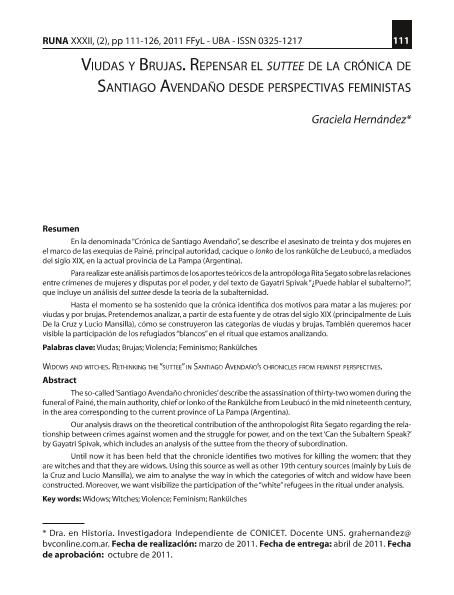Mostrar el registro sencillo del ítem
dc.contributor.author
Hernandez, Graciela Beatriz

dc.date.available
2018-12-27T20:28:04Z
dc.date.issued
2012-01
dc.identifier.citation
Hernandez, Graciela Beatriz; Viudas y Brujas: Repensar el suttee de la crónica de Santiago Avendaño desde perspectivas feministas; Universidad de Buenos Aires. Facultad de Filosofía y Letras. Instituto de Ciencias Antropológicas; Runa; 32; 2; 1-2012; 111-126
dc.identifier.issn
0325-1217
dc.identifier.uri
http://hdl.handle.net/11336/67115
dc.description.abstract
En la denominada “Crónica de Santiago Avendaño”, se describe el asesinato de treinta y dos mujeres en el marco de las exequias de Painé, principal autoridad, cacique o lonko de los rankülche de Leubucó, a mediados del siglo XIX, en la actual provincia de La Pampa (Argentina). Para realizar este análisis partimos de los aportes teóricos de la antropóloga Rita Segato sobre las relaciones entre crímenes de mujeres y disputas por el poder, y del texto de Gayatri Spivak “¿Puede hablar el subalterno?”, que incluye un análisis del suttee desde la teoría de la subalternidad. Hasta el momento se ha sostenido que la crónica identifica dos motivos para matar a las mujeres: por viudas y por brujas. Pretendemos analizar, a partir de esta fuente y de otras del siglo XIX (principalmente de Luis De la Cruz y Lucio Mansilla), cómo se construyeron las categorías de viudas y brujas. También queremos hacer visible la participación de los refugiados “blancos” en el ritual que estamos analizando.
dc.description.abstract
The so-called ‘Santiago Avendaño chronicles’ describe the assassination of thirty-two women during the funeral of Painé, the main authority, chief or lonko of the Rankülche from Leubucó in the mid nineteenth century, in the area corresponding to the current province of La Pampa (Argentina). Our analysis draws on the theoretical contribution of the anthropologist Rita Segato regarding the relationship between crimes against women and the struggle for power, and on the text ‘Can the Subaltern Speak?’ by Gayatri Spivak, which includes an analysis of the suttee from the theory of subordination. Until now it has been held that the chronicle identifies two motives for killing the women: that they are witches and that they are widows. Using this source as well as other 19th century sources (mainly by Luis de la Cruz and Lucio Mansilla), we aim to analyse the way in which the categories of witch and widow have been constructed. Moreover, we want visibilize the participation of the “white” refugees in the ritual under analysis.
dc.format
application/pdf
dc.language.iso
spa
dc.publisher
Universidad de Buenos Aires. Facultad de Filosofía y Letras. Instituto de Ciencias Antropológicas
dc.rights
info:eu-repo/semantics/openAccess
dc.rights.uri
https://creativecommons.org/licenses/by-nc-sa/2.5/ar/
dc.subject
Viudas
dc.subject
Brujas
dc.subject
Feminismo
dc.subject
Violencia
dc.subject.classification
Antropología, Etnología

dc.subject.classification
Sociología

dc.subject.classification
CIENCIAS SOCIALES

dc.title
Viudas y Brujas: Repensar el suttee de la crónica de Santiago Avendaño desde perspectivas feministas
dc.title
Widows and witches: Rethinking the “suttee” in Santiago Avendaño’s chronicles from feminist perspectives
dc.type
info:eu-repo/semantics/article
dc.type
info:ar-repo/semantics/artículo
dc.type
info:eu-repo/semantics/publishedVersion
dc.date.updated
2018-11-26T13:29:54Z
dc.journal.volume
32
dc.journal.number
2
dc.journal.pagination
111-126
dc.journal.pais
Argentina

dc.journal.ciudad
Buenos Aires
dc.description.fil
Fil: Hernandez, Graciela Beatriz. Universidad Nacional del Sur. Departamento de Humanidades. Centro de Estudios Regionales; Argentina. Consejo Nacional de Investigaciones Científicas y Técnicas. Centro Científico Tecnológico Conicet - Bahía Blanca; Argentina
dc.journal.title
Runa
dc.relation.alternativeid
info:eu-repo/semantics/altIdentifier/url/http://revistascientificas.filo.uba.ar/index.php/runa/article/view/709
Archivos asociados
